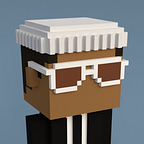When retro graphics weren’t retro
I was born into an analog world. Radio dials that had to be turned to tune in the station frequency. Black & White televisions that would distort to static noise when the antenna was in the wrong position.
Still I was enchanted by technology– which was electronics. You could take things apart and see how things work. Kind of.
Everything was wood-grained. I had a flip-number clock. I played handheld games, imagining that red lights in the display represented baseball players rounding the bases.
Moving into the 80s, the world started to change. Clocks were digital, and had LED 7-segment displays.
We got video games, first in the arcades, then at home with the Atari 2600 (still wood-grained), and then finally — the Apple ][e.
I was fascinated by the graphics. 1 pixel appeared as green or purple depending on which position it appeared in. Both together would give you a 2 pixel-wide white dash.
What did kids do before videogames? In my case, as soon as I could pick up a pen or pencil — I drew stories and comic adventures. So when technology reached the point where I saw drawings on a computer screen– it was magical, and I wanted to know how to do it.
At the time, if you wanted to understand the medium of computer graphics, you had to become supremely acquainted with the nature of bits and pixels. You made a pixel switch on or off, bit-by-bit, until you had a picture.
As graphics got more sophisticated, you were able to fit more colors into a single pixel. Or, specifically, you could address a single pixel which, up-close was a red light, next to a green light, next to a blue light– RGB displays.
I remember holding a magnifying glass up to the, now color, television and being fascinated by how all of the images were composed of those three lights.
Computer graphics had to create these colors, these RGB pixels, digitally. So each pixel was represented by bits. Ones and Zeros that represent whether the red or green or blue part of the pixel is lit up, so 111 would be white, 000 would be black and 100 would be red.
All of these combinations meant that you have 8 colors to work with, since when Red + Blue are lit up, you get Magenta.
I was amazed by how the graphics programs and games were able to use patterns to create more colors than what was actually available in the system. I used to note down different color patterns and the apparent colors they would create– to use as ‘fill patterns’ in my own drawings.
I couldn’t imagine how to discover all the different possible color combinations.
Skip ahead 30 years or so, and I was entering various indie game jams, with various degrees of success in completing a game in my free time. When I discovered #LowRezJam, I was so enthralled that I completed my game Zombie Sniper with time to spare.
By imposing limitations on the graphics, not only did it make it possible for me to complete the game during the competition, it also sparked a memory of all the games and graphics I made in my youth, when those limitations were inescapable.
From that competition, I started developing some graphics tools around the retro style I remembered, and finally fulfilled the childhood dream of being able to browse every possible pixel pattern when I made a project called VGA Pattern
First in a series about my upcoming blockchain collectible Art Blocks project, 27-Bit Digital.
My project launches Friday, 19 Feb 2021 @ 9am PST / 5pm GMT
Further reading about 27-Bit Digital
- Deciphering 27-Bit Digital — About the project in detail
- 27-Bit Digital to Physical
- In Conversation: Kai Turner — An interview with Jeff Davis
- Pixel Glass : Glass Print — My second Art Blocks drop
